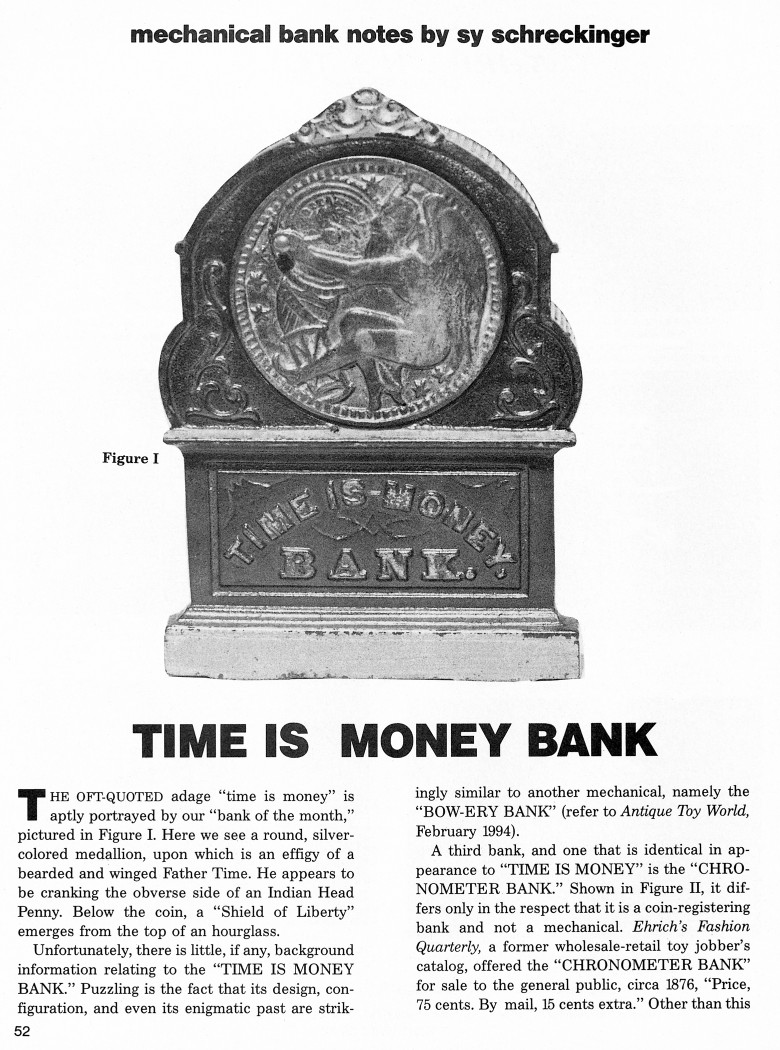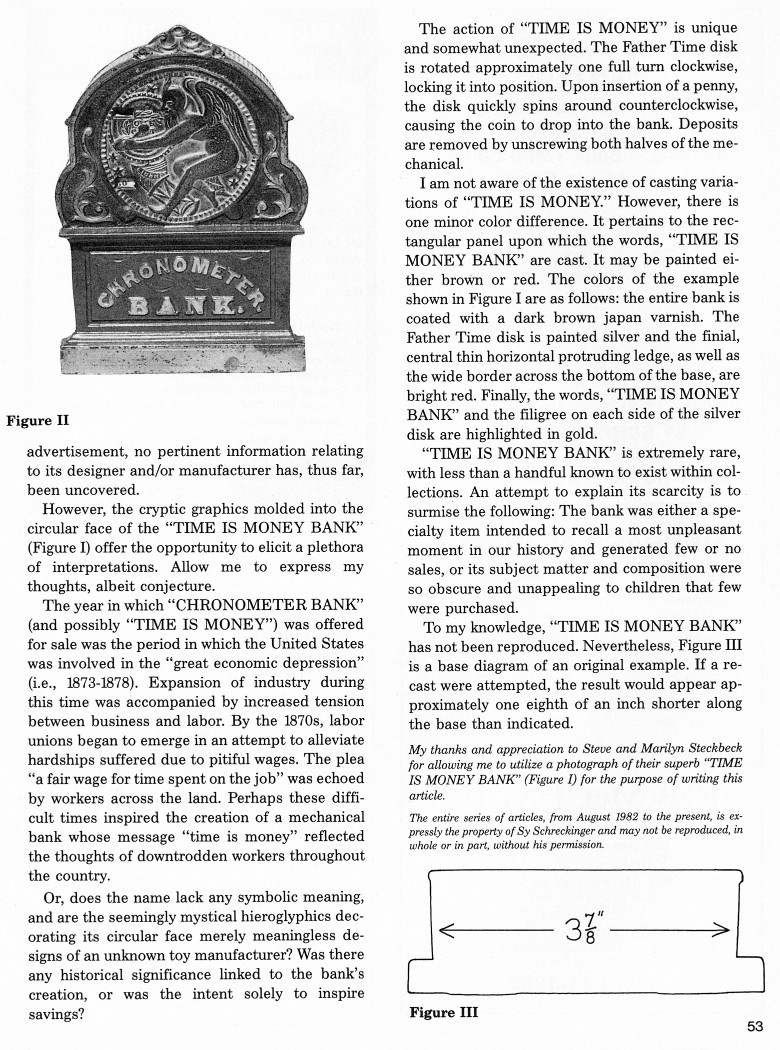|
Time Is Money Bank
by Sy Schreckinger – ANTIQUE TOY WORLD Magazine – April, 1994
The oft-quoted adage "time is money" is aptly
portrayed by our "bank of the month," pictured in Figure I. Here we see a
round, silver-colored medallion, upon which is an effigy of a bearded and
winged Father Time. He appears to be cranking the obverse side of an
Indian Head Penny. Below the coin, a "Shield of Liberty" emerges from the
top of an hourglass.
Unfortunately, there is little, if any, background information
relating to the "TIME IS MONEY BANK." Puzzling is the fact that its
design, configuration, and even its enigmatic past are strikingly similar
to another mechanical, namely the "BOW-ERY BANK" (refer to Antique Toy
World, February 1994).
A third bank, and one that is identical in appearance to "TIME IS
MONEY" is the "CHRONOMETER BANK." Shown in Figure II, it differs only in
the respect that it is a coin-registering bank and not a mechanical. Ehrich's Fashion Quarterly, a former wholesale-retail toy jobber's
catalog, offered the "CHRONOMETER BANK" for sale to the general public,
circa 1876, "Price, 75 cents. By mail, 15 cents extra." Other than this
advertisement, no pertinent information relating to its designer and/or
manufacturer has, thus far, been uncovered.
However, the cryptic graphics molded into the circular face of the
"TIME IS MONEY BANK" (Figure I) offer the opportunity to elicit a plethora
of interpretations. Allow me to express my thoughts, albeit conjecture.
The year in which "CHRONOMETER BANK" (and possibly "TIME IS MONEY")
was offered for sale was the period in which the United States was
involved in the "great economic depression" (i.e., 1873-1878). Expansion
of industry during this time was accompanied by increased tension between
business and labor. By the 1870s, labor unions began to emerge in an
attempt to alleviate hardships suffered due to pitiful wages. The plea "a
fair wage for time spent on the job" was echoed by workers across the
land. Perhaps these difficult times inspired the creation of a mechanical
bank whose message "time is money" reflected the thoughts of downtrodden
workers throughout the country.
Or, does the name lack any symbolic meaning, and are the seemingly
mystical hieroglyphics decorating its circular face merely meaningless
designs of an unknown toy manufacturer? Was there any historical
significance linked to the bank's creation, or was the intent solely to
inspire savings?
The action of "TIME IS MONEY" is unique and somewhat unexpected. The
Father Time disk is rotated approximately one full turn clockwise, locking
it into position. Upon insertion of a penny, the disk quickly spins around
counterclockwise, causing the coin to drop into the bank. Deposits are
removed by unscrewing both halves of the mechanical.
I am not aware of the existence of casting variations of "TIME IS
MONEY." However, there is one minor color difference. It pertains to the
rectangular panel upon which the words, "TIME IS MONEY BANK" are cast. It
may be painted either brown or red. The colors of the example shown in
Figure I are as follows: the entire bank is coated with a dark brown japan
varnish. The Father Time disk is painted silver and the finial, central
thin horizontal protruding ledge, as well as the wide border across the
bottom of the base, are bright red. Finally, the words, "TIME IS MONEY
BANK" and the filigree on each side of the silver disk are highlighted in
gold.
"TIME IS MONEY BANK" is extremely rare, with less than a handful
known to exist within collections. An attempt to explain its scarcity is
to surmise the following: The bank was either a specialty item intended to
recall a most unpleasant moment in our history and generated few or no
sales, or its subject matter and composition were so obscure and
unappealing to children that few were purchased.
To my knowledge, "TIME IS MONEY BANK" has not been reproduced.
Nevertheless, Figure III is a base diagram of an original example. If a
recast were attempted, the result would appear approximately one eighth
of an inch shorter along the base than indicated.
My thanks and appreciation to Steve and Marilyn Steckbeck for
allowing me to utilize a photograph of their superb "TIME IS MONEY BANK"
(Figure I) for the purpose of writing this article.
The entire series of articles, from August 1982 to the present, is
expressly the property of Sy Schreckinger and may not be reproduced, in
whole or in part, without his permission.
|


